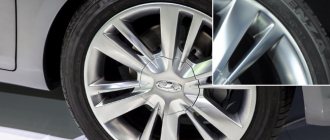Test drive Lada Vesta: review, photos and videos
Once upon a time, Tolyatti Ladas were very popular in the post-Soviet space.
Many people dreamed of such a car. But time passes, and foreign cars have successfully replaced the products of the native automobile industry. Foreign cars were more attractive in appearance, more convenient to use, more reliable, and so on. Plus, they've always been more fashionable. In general, our auto industry was inferior to imported ones in all respects. It has become more profitable to buy a used, but foreign car than a new domestic car.
But now new Ladas have appeared on the assembly line, and the patriots of the domestic automotive industry have new hope.
The head of state himself began the test drive for the Lada Vesta car. Actually, as befits a leader interested in developing domestic production, and not in feeding foreign producers.
Of course, such a test drive could not be unsuccessful. That is why many car enthusiasts simply did not believe the results. But then independent experts - journalists, potential buyers and simply motorsport fans - got down to business.
And here the Lada Vesta test drive turned out to be much more interesting.
What do they offer for our money?
Quite a reasonable price for a new car. For this money the buyer receives:
- fog lights;
- power windows for rear doors;
- heated windshield;
- light and rain sensors;
- armrest for the driver's seat;
- wheels (16-inch).
The engine is from today's usual economical series: volume 1.6 liters, power 106 hp. With.
If you wish, you can pay an additional 25 thousand rubles and get a robotic gearbox - a cross between an “automatic” and a manual gearbox, which is popular today (in fact, a manual gearbox that is controlled electronically and not directly by the driver).
You can also invest some money and expand the “luxury” offered by getting the XV Line kit, which includes such wonderful gadgets as a spoiler, exhaust tip, pedal covers, cruise control, rear view camera, touch screen and navigation. This option will cost 663 thousand rubles.
At the first glance at the LADA Vesta, it becomes obvious: this car has no noticeable national features; it can be called a typical car in its class. This Lada is too similar to a foreign car to immediately recognize it as a product of the domestic automobile industry.
But maybe this is for the better: the current generation of drivers no longer remembers the times when the Lada was considered the ultimate dream, but it has a certain stereotype about what a car should look like. Actually, the Lada Vesta looks like this - in full accordance with the expectations of car enthusiasts.
The X-shaped design, chosen by the new head of AvtoVAZ style, Steve Mattin, gives the LADA Vesta some imported charm.
Source: https://RuliKolesa.ru/lada-vesta-test-drajv/
Test drive and review of Lada Vesta and XRey from Autoreview 2020 + video
Journalists and experts from Autoreview conduct a resource test: Lada Vesta and Lada XRAY.
They say the future approaches much faster if you meet it halfway. This is roughly what we are doing at Autoreview now. I am located near our technical center at the Dmitrovsky Automotive Test Site, and next to me is the Lada XRAY and Lada Vesta. Both undergo accelerated life tests "Autoreview". Why did I talk about the future? Yes, because both cars will have to travel about 32,000 kilometers along the varied roads of the test site, but the load on them will be such that one kilometer is equivalent to three kilometers of normal everyday use, that is, in 4-5 months we will simulate about five years of their life and hundred thousand mileage.
Corrosion tests of Lada Vesta
The second no less important part is corrosion testing. On the body of each car, on each body element, three calibrated cuts of paint are applied: one deep to the metal, the second to the ground, and the third imitates a small scratch.
Why is this done? The cars will spend about 6-10 hours in a chamber with salt fog, and we will see how their body will feel in five years. For the Lada XRAY, in terms of the corrosion resistance of the body, we have no questions yet, but I can say the same about the Vesta I can not. The deepest cut of the paint (the one that goes deep into the metal) rusted after the first visit to the corrosion chamber, after six hours spent in salt fog, and after the second visit we found rust in the second cut (the one that goes to the ground).
But I must say that on the remaining body elements all the cuts feel great and there is no corrosion anywhere else yet. The same, again, cannot be said about the condition of the parts under the hoods of cars and underneath cars. Let's see what the salt has done under the hood. The cars didn’t spend much time in the corrosion chamber, so I don’t see any crime, but elements such as mounting brackets, clamps or the battery bar are quite seriously corroded, and we see the paint peeling off, so in the future the picture will only get worse.
And as for the Lada XRAY, it has about the same picture under the hood. Let's see what we have underneath the car. I see traces of corrosion on the brake drums, on the exhaust system elements, on the rear suspension beams, on the front wheel drives (they are quite rusty). If we remember about the LadaXRAY, the picture below is about the same. The only difference that Vesta has that is not the best is that there is corrosion in the chips on the spar.
Life tests of Lada Vesta and Lada XRey
By the way, both cars have already covered 8,000 kilometers, that is, about a quarter of the distance, and we already have the first results. Vesta has problems with fastening the exhaust part. At 6,200 kilometers, the front mount broke, then knocking noises began to be heard from the rear, and we discovered that the muffler mounting bracket had fallen off and had to be welded into place. And at about 8,000 kilometers, that is, quite recently, we discovered that the middle suspension of the exhaust tract had also torn.
Once Vesta almost lost her driver, and this is how it happened: if you open the door handle so that it moves back a little, then the handle sticks in this position, and the door pretends to be, but does not lock. Moreover, this problem occurs not only with the driver’s door handle, but also with the other doors. Be careful!
We have even more questions for the Lada XRAY; they are all concentrated under the hood and began to appear even before the start of the test run. When the odometer showed only 43 kilometers, a problem arose with the generator: a nut was unscrewed from its shaft, a pulley was lost, the belt came off, and the car had to be sent back to the dealer by tow truck, where the generator assembly was replaced. Then the expansion tank of the cooling system leaked and leaked along the weld seam.
We soldered it, but it didn’t last long, we had to buy a new tank. This is a problem not only for our car; about 1,300 cars have received defective tanks, and if the owners contact them, they will be replaced under warranty. But the saddest thing is that there are also questions about the new VAZ 1.8 engine. When operating for a long time at high speeds, about 5,600, the checkengine signal turns on, misfires appear and the engine begins to simply stall. Naturally, we told VAZ engine engineers about these problems, and now a new engine control program is being developed. Most of the mileage takes place on the highway. In total, both cars will spend 20,000 kilometers here.
Now we are driving a Lada Vesta, its maximum speed is about 185 km/h. The car will go part of the way simply at maximum speed, part with engine braking, part with braking of the service brake system.
As you can see, I am not alone in the salon. Almost half of the run will be carried out with me by three water-filled dummies, weighing 75 kilograms each, and ballast in the trunk - 50 kilograms of lead shot in bags. If a high-speed road primarily affects the engine, acceleration and braking affects the transmission, then a cobblestone road, of course, affects the suspension and the driver. For example, in the XRAY the steering wheel hits your hands a lot, but in the Lada Vesta you need to follow the succession of waves of the coating, the karma jumps great, right up to a short circuit on the bump stop, and the greater the load, the more pronounced this is. Now I’m driving an XRAY, almost the entire cabin is talking: the dashboard, glove compartment, door trims are creaking. And there is an interesting point that on the biggest bumps the wipers turn on by themselves, the lever jumps to the position where they are turned on, which is what happened now, for example. On a mountain road, cars will last 2,000 kilometers. The speeds here are lower than on the expressway, 100 km/h on straights, 60 km/h in corners, we save the tires. On descents we brake with the engine and accelerate with the pedal to the floor. The cars behave quite predictably even with a full load; we don’t have any special comments about them here. And every 100 kilometers we drive up a 10% grade in reverse, load the reverse gear, and at the same time the clutch. The name of the exercise “Acceleration - Braking” speaks for itself - this is the most intense acceleration in each gear, then engine braking in the opposite direction and stopping using the standard brake system. Here we load both the brakes and the gearbox as much as possible. And it must be said that during the previous endurance tests in which the Lada Granta car took part, the manual transmission failed, we repaired it. The French gearbox on the Lada Vesta feels good so far, as does the robot on the Lada XRAY. The mileage on dirt roads is not too long, only 400 kilometers, the shortest exercise. And here we look at how the car body resists dust and dirt. Yes, I almost forgot, in addition to the main running part of the test and the corrosion chamber, we conduct so-called additional tests, that is, we slam the trunk lid hundreds of times, fold out the backrests of the rear seat, adjust the front seat, raise and lower the windows, adjust the mirrors, slam all the doors without exception. That is, we do everything that happens to a car body in three to five years. And the accelerated life tests are completed not by a laurel wreath and champagne, but by a crash test, but not at high speed, but at only 15 km/h, the so-called insurance crash test or Danner crash test. Its result is the cost of restoring a car after a minor urban accident. And at the very end we summarize the main financial results of all tests.
Lada Vesta test drive
The first full test drive of the Lada Vesta left quite good impressions of the new product of the domestic automobile industry.
Yes, the car has some drawbacks; it is still in the middle price category, not the premium one, but many buyers will simply turn a blind eye to them.
And all because the overall quality level of the new Vesta is at a very high level, which was not previously available to any domestic company.
Vesta test drive
The appearance of the LADA Vesta leaves no one indifferent - the car turned out to be beautiful from any angle, and even minor changes since the presentation of the concept did not make the new product worse. Yes, the headlights now have a more “down to earth” design, the roof line has been slightly raised for greater comfort for rear passengers, but all these changes are organic, they do not spoil the design at all.
The most complaints in the design are about the X-shaped stampings, which emphasize the new corporate style of the LADA brand.
But my personal opinion is that this is an excellent design decision that matches the overall style of the car and increases the rigidity of the body and doors.
In addition, this solution makes the new product stand out among all cars in its class - it adds a certain individuality that many modern models lack.
In Vesta’s cabin, everything is quite laconic, simple in some ways, but convenient. Every detail, every control element is in its place.
It's time to get more comfortable in the driver's seat - the door slams with a noble sound, to which the owners of foreign cars are accustomed. Having pushed the driver's seat back all the way, it was discovered that with a height of 185 cm, it is problematic to reach the pedals, but on the back seat, even in this extreme position, you can it was possible for three riders to get comfortable.
The upholstery turned out to be of high quality and practical. The quality of fitting of different interior elements to each other did not cause any complaints either. The controls work well and smoothly, the dashboard has excellent information content and the readings are excellent, helped by the soft illumination of the scales.
During the first Lada Vesta test drive, we found fault with only one element of the interior - the button for the front window lifter of the passenger door is located too close to the door opening handle, but you can quickly get used to such a small detail.
The trunk of the LADA Vesta will be the envy of almost any classmate; its volume is 480 liters. Only the undisputed leader Renault Logan has more - 510 liters, as well as the two Koreans Hyundai Solaris and Kia Rio, which have 500 liters each.
Some of the trunk space is obscured by outdated trunk lid hinges, but that's minor compared to the low loading height, depth, and spaciousness of the trunk, which also has a full-fledged spare tire in a hidden cavity under the trunk floor.
Dynamic test drive of Vesta
The car roars from a stop, although the dynamics cannot be called sporty. Of course, AVTOVAZ engineers did everything possible so that, if necessary, the driver could “press down on the gas” and get adrenaline from several sharp accelerations and braking, but you shouldn’t expect too much from the car.
One of the main merits of the participation of Renault-Nissan alliance engineers in the development of the Lada Vesta is the excellent combination of a domestic engine and a foreign manual transmission. There is a small complaint about the “mechanics” - gear shifting is a little difficult, but in the future this problem should disappear.
As for the automated transmission, it was a little more disappointing - there are dips in revolutions and speed, which is simply unacceptable during aggressive driving and overtaking.
Manual gear shifting, of course, saves this gearbox, but then what’s the point of abandoning the alliance’s “mechanics” in favor of a “robot”?
The car handles quite well - there is a clear “zero” of the steering wheel and the steering wheel constantly strives to go to exactly this position. Numerous assistance systems help keep the car on the correct trajectory and avoid skidding.
On high-speed straights, the car performs simply great, thanks to the precise tuning of the suspension; in urban conditions there will also be no discomfort due to the very energy-intensive suspension, small turning radius and large rear-view mirrors.
On the rough roads of the Lada Vesta, a test drive showed that the car will feel no worse than Kalina and Granta.
There is a high ground clearance of 171 mm at full load, protection for the power unit, as well as an “anti-gravel” coating on the bottom and sills.
Add to this a large 55-liter gas tank, doors that prevent snow from getting into the interior when opened, and a galvanized body with a 6-year warranty, and you will get almost an ideal car for a wide variety of operating conditions.
Options and prices
Journalists were given mid-range versions of the Lada Vesta for a test drive.
Results of the 60-hour endurance race
Brake pad wear:
- Hyundai Creta - 1.83 mm/1000 km. That is, their resource is about 45,000 km.
- Ford Focus - 2.5 mm/1000 km (33,000 km).
- Lada Vesta SW - 3.17 mm/1000 km (23,000 km).
- Lada Vesta SW Cross - 3.69 mm/1000 km (21,000 km).
Before the start of the tests, the engine oil in all cars was changed to new one. At the end of the marathon, oil samples were taken and sent to the laboratory for analysis:
- In Lada Vesta SW, Lada Vesta SW Cross and Ford Focus, all indicators are normal. There is silicon, which indicates the infiltration of the finest road dust. This is normal after a certain number of kilometers of mud have been covered.
- Not only silicon was found in the Hyundai Creta, but also an increased content of copper. Judging by its quantity, the engine was wearing out three times more intensively than during normal operation.
We were looking for the maximum temperature at which cars start. To simulate short city trips in winter, the cars were frozen to -25 °C, then the engines were started. They turned it off when the coolant reached 40 °C. Then - freezing again and starting again. And so - ten cycles for each machine. After completing the test cycle, oil samples were taken:
- An increased iron content was observed in the engine oil of all cars - this is a direct consequence of engine wear.
- In Hyundai Creta, in addition to the high metal content in the oil, its viscosity has dropped so much that it can harm the engine. Factory oil is not ready for such conditions.
- Lada Vesta SW, Lada Vesta SW Cross and Ford Focus also showed high levels of metals in the oil, but the situation is better.
Conclusion
(link to ZR article):
- Ford Focus swallows even serious potholes without problems, the engine tolerates heavy loads and high speeds well. But on a snow-covered highway, the Focus instantly becomes covered in snow, and the modest ground clearance forces you to be especially vigilant on uneven roads.
- Hyundai Creta behaved excellently on broken dirt roads and gave no cause for concern in ruts. But it lacks stability on slippery roads, which is especially noticeable compared to other cars. A glitch in the tire pressure monitoring system also alerted me. The most serious complaint arose after oil analysis. The Creta does not tolerate frequent cold starts and constant high revs.
- Lada Vesta SW is a real SUV. The ground clearance is higher, the energy intensity of the suspension is higher. It is necessary to understand the voltage in the network. Devices are not allowed to turn off even at the highest speeds! The same goes for the Cross version.
- The Lada Vesta SW Cross is annoying due to excessive body rocking, and low-profile tires reduce the effect of the impenetrable chassis - a hernia, a punctured tire and a jammed wheel are witnesses to this. The engines of both Wests proved to be resistant to heavy loads. It was their engines that showed the least wear - even after cold starts.
Heating efficiency:
- Ford Focus
- Hyundai Creta
- Lada Vesta SW and Lada Vesta SW Cross
The Kar-index takes into account operating costs for 70,000 km - these are registration and technical inspection fees, transport tax, MTPL costs, fuel costs and scheduled maintenance, as well as sales losses:
CAR MILEAGE DURING THE MARATHON, km
| FORD FOCUS | HYUNDAI CRETA | LADA VESTA SW CROSS | LADA VESTA SW | |
| Total mileage | 2724 | 2695 | 2578 | 2632 |
| cobblestone road | 565 | 565 | 536 | 560 |
| Braking | 573 | 560 | 539 | 524 |
| Driving at maximum speed in third gear | 1099 | 1098 | 1084 | 1099 |
| "Mountain road | 182 | 136 | 130 | 204 |
| Dirt road | 305 | 336 | 289 | 245 |
NOISE AT SPEED 120 KM/H, dB
| FORD FOCUS | HYUNDAI CRETA | LADA VESTA SW CROSS | LADA VESTA SW | |
| With box on the roof | 74,4 | 73,95 | 75,7 | 75,6 |
| Without boxing | 69,9 | 69,4 | 71,3 | 71,7 |
| Difference | 4,5 (6,4%) | 4,55 (6,5%) | 4,4 (6,1%) | 3,9 (5,4%) |
FUEL CONSUMPTION
| FORD FOCUS | HYUNDAI CRETA | LADA VESTA SW CROSS | LADA VESTA SW | |
| Total spent | 315.00 l | 337.35 l | 333.06 l | 337.15 l |
| Average consumption for the entire marathon | 11.56 l/100 km | 12.52 l/100 km | 12.91 l/100 km | 12.81 l/100 km |
| Average consumption at a speed of 120 km/h with roof box | 10.46 l/100 km | 10.72 l/100 km | 11.19 l/100 km | 10.94 l/100 km |
| Average consumption at a speed of 120 km/h without roof box | 9.98 l/100 km | 9.84 l/100 km | 10.15 l / 100 km | 10.11 l/100 km |
WEAR OF TIRES AND BRAKE PADS
| FORD FOCUS | HYUNDAI CRETA | LADA VESTA SW CROSS | LADA VESTA SW | |
| Average tire wear | 3.62 mm / 1000 km | 2.53 mm / 1000 km | 3.25 mm / 1000 km | 3.33 mm / 1000 km |
| Theoretical tire life during normal use | 21,000 km | 32,000 km | 25,000 km | 23,000 km |
| Brake pad wear | 2.5 mm / 1000 km | 1.83 mm / 1000 km | 3.69 mm / 1000 km | 3.17 mm / 1000 km |
| Theoretical pad life during normal operation | 33,000 km | 45,000 km | 21,000 km | 24,000 km |
Let us remind you that the editorial fleet includes a Lada Vesta sedan in the Luxe configuration. This car has already covered 50,000 km. Previously, experts from the auto magazine told us what problems the editorial Vesta had in recent times.
Keywords: Lada Vesta Cross
14
1
Found an error? Select it and press Ctrl+Enter..
- The most common electric cars in the Russian Federation as of mid-2020
- Clubturbo is developing the Lada Vesta DFTZ (for drifting)
- Manufacturing and installation of an organizer in the LADA glove compartment
- Review of cold intake kits for Lada Vesta Sport (analogues)
I went for a test drive of Lada Vesta
February 4, 2016
So, I took the Lada Vesta for a test drive and I hasten to share my impressions. Only a lazy blogger/journalist/and just a car enthusiast has not written, shown, told or joked about Vesta lately. I’ll throw my 3 rubles 40 kopecks into this topic.
So, early in the morning, on a day off, I’m at the dealer’s door. I’m waiting for 9-00 in the morning and the managers, joyfully taking up their work, sign me up for a test drive of the little white Lada Vesta .
Before this long-awaited moment arrived, I must admit, I managed to climb all over Vesta, one on the street, and a couple in the showroom. The first impression is another Kia Rio - Solaris - Focus and others from that company. Well, that’s good, it means VAZ did everything right.
My brief report will not contain technical characteristics, there are plenty of them on the Internet, as well as statements of dry little things. I will turn off my brain as much as I can and make my subjective verdict.
I won’t freeze for a long time and will speak out right away. The car is fire. If I decide to change the rear or all-wheel drive, and want to find a front-wheel drive, Vesta is the one. Even if suddenly, somewhere in its depths, pelvic shoals pop up - to hell with them, I’ll forgive everything. She's cool, that's for sure.
But only as a city asshole, from work to work, children to school, weekends - dacha. Something like that. This is not a car for traveling - it’s a bit small in size, this is not a car to “kick someone’s ass”, for this it needs to be mercilessly tuned like an adult.
This is a smooth city car, with a cool design, which will give real patriots the opportunity not to feed a Hyundai Kia, but to support a VAZ.
About the pricing policy - sadness and melancholy. There seems to be no Vesta for 514 thousand in nature. Average equipment is closer to 600 thousand, I scanned the full price list at the end of the article. Please note that prices are net and for the start of sales. Draw a conclusion.
I will devote a whole paragraph to the robotic transmission, although it can be done in one word. The Lada Vesta robot is sad G. Why they put this rubbish in a good car, I can’t say.
However, it is known that robots have a lot of advantages: they are unreliable, expensive compared to mechanics, and slow if installed in a mass-market car. Vesta's robot is no exception. During the test drive, the manager praised the box for its manual mode.
It's cool and comfortable, yes. But there is nothing from him at all. The secret is simple: in manual or automatic D-mode, the box changes gears in as much as 2 seconds! Karl, wake up, we've been robbed!! 2 seconds, Karl...
That’s all I have, the drool of rage is dripping onto the laptop keyboard, I’ll take pity on my equipment, and forget about the sad Vesta robot. Stay away from him, my personal opinion.
Let's move on to the appearance. The tinsmith's thunderstorm, the new X-shaped, or ugly stamping. In fact, of course, it complicates the element, but I would not say that no one would ever be able to straighten it. For me, they made it too deep, I don’t know, subjectively, I would rather refuse it, given the opportunity to choose.
On the one hand, the design is cool, but I have the feeling that this is a designer “bookmark”. This is when they make it so that at first you really like the car, but after a couple of years, the model becomes familiar and begins to irritate you.
Looks like this X is from this series. I don’t know, I’m talking about markers. Not a nine after all, a car with ambitions and a pronounced zest. There is something to gossip about, viral marketing, etc.
Okay, empty X is emblazoned on the sides, he’ll fall in love with it.
I liked the salon, no offense to Tagaz’s accent - well, there’s no comparison. What can I say, the Solaris, in my opinion, is nauseating compared to the Vesta’s interior, at least I often ride a Solaris with a friend as a passenger.
I don't like the design of the dashboard, the beard and the front end in general. And the new fret has an interesting one. The X on the multimedia system also infuriates. I’ll also say that Sony had a line of x-plod radio tape recorders, this reminds me of them. For the interior in its class 5 minus.
No delight, just good.
In conclusion, I would like to note that a cool car has appeared among the most popular and competitive segment. I sincerely wish Vesta to break the market for Riosolaris and throw them out of the top sales list. Let it be everywhere and become familiar, but it’s ours, and it will bring us income in the form of taxes and jobs. Honestly, I’m glad, I think Vesta was a success.
Source: https://cariolis.ru/autoblog/event/test-drajv-lada-vesta/
Why is Vesta so expensive?
Over the years of designing and developing Vesti, the market situation has changed greatly. Everyone was expecting Vesta for 350-400 thousand rubles, but they received it for 550-650 thousand rubles. I don’t see AvtoVAZ as particularly at fault here. Unfortunately, our country's economy is almost entirely dependent on the price of oil and gas. While oil cost $80 - $130 per barrel, the authorities had the opportunity to invest excess income in industrial development, agriculture, high-tech production and training. The most they did was simply save money in the stabilization fund.
Now oil costs 30 dollars. To meet budget requirements, a barrel of oil must be sold for 3,000 rubles. Divide 3000 by 30 - it turns out 100. This is the dollar exchange rate at which the current budget will be replenished normally. But the exchange rate is now around 80 rubles. Accordingly, the budget will receive a 20% shortfall. On the other hand, prices for goods and services purchased abroad have almost tripled for us.
For the entire developed world, falling oil prices are a gift. Since the cost of almost any production is falling. The price of gasoline is falling. The only countries that suffer are those where production is not developed, and the main income comes from the banal sale of minerals. By the way, our price of gasoline in dollars has fallen by almost 3 times. It’s a pity that all monetary transactions are carried out in rubles.
Vesta is far from being 100% made from domestic components. If we take the price of Vesta in dollars, then previously it was planned for 400 thousand rubles, with a dollar price of 30. This is approximately 13,300 dollars. And now it costs 600 thousand rubles, with the price of a dollar being 80. That is, it has fallen in price to 7,500 dollars. $7,500 is an incredibly low price. I think that in Europe Vesta can take a certain market share at this price.
Lada Vesta test drive video
So September 25th arrived. Probably, Russian car enthusiasts have not looked forward to a single day in 2020 with such impatience. After all, it was today that AvtoVAZ began serial assembly of the Lada Vesta, a new domestic sedan that promises to become an epoch-making model for our automobile industry.
From the very morning, the VAZ plant in Izhevsk was literally besieged by journalists of all stripes who wanted to ride the new car and quickly convey their impressions to the public. Of course, any assessment is subjective, so you should not rely on one opinion, even the most authoritative one. However, this entire stream of statements gradually develops into a coherent picture.
Mikhail Podorozhansky - editor-in-chief of AutoReview magazine
Vesta is a beauty!
The appearance of the car is simply amazing, especially compared to Kalin and Grant. And so much so that you begin to look around in order to once again make sure that you are on the territory of VAZ, and not some Korean automobile plant.
But no, everything is true, and the faces of Russian factory workers glowing with pride only encourage them, forcing them to speed up their pace. The main thing is not to get bogged down in trifles and force yourself to be as objective as possible, and this is oh so difficult!
Differences between the concept and production version
So what are the differences between the serial Vesta and the concept? After all, we know many examples when a bright and individual concept completely lost all its trump cards, turning into a production model. Of course, partly this fate befell Vesta, but still, how similar she is to a charismatic concept!











